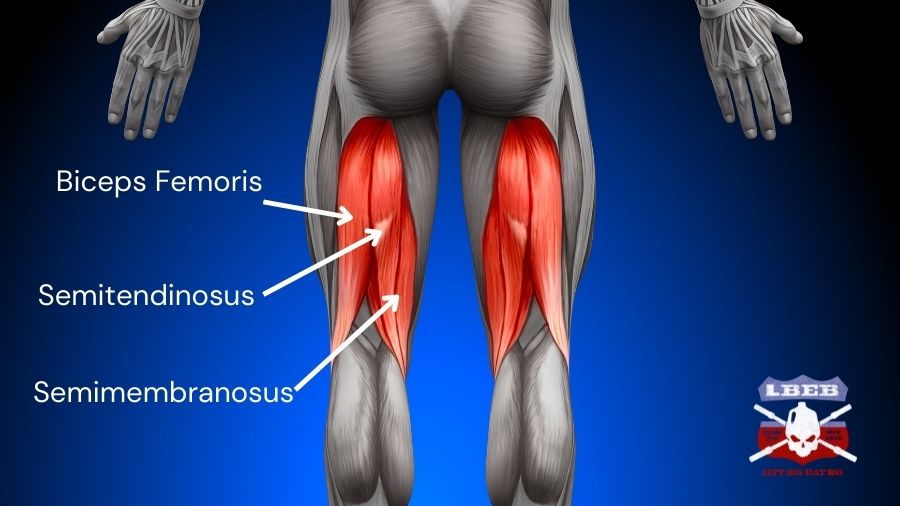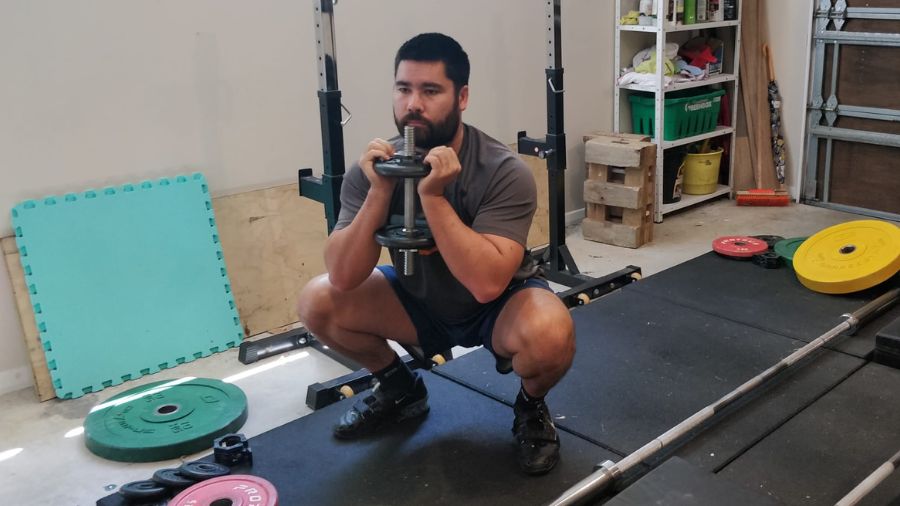Leg muscles can be hard to grow. Especially when training them is far more painful than the upper body muscles. Many will say all you need are squats to get huge legs. But does this take into account the hamstrings?
While squats will build big legs, they don’t work the hamstrings. Simultaneous hip and knee flexion and extension mean the hamstrings don’t change in length and are not a heavily recruited muscle group.
But what about other squat variations? And what happens if you squat deep?
Table of Contents
Hamstring Anatomy
The hamstrings are not one muscle. They consist of three main muscles:
- Semimembranosus (inner hamstring)
- Semiteninosus (middle hamstring)
- Biceps femoris (outer hamstring)

The hamstrings are unique muscles as they cross two joints, making them biarticular. That means they serve two main movement functions knee flexion and hip extension. Knee flexion exercises preferentially target the inner hamstrings, while hip extension exercises target the outer hamstrings [1].
This information sets the stage for why squats don’t work the hamstrings.
Do Squats Work Hamstrings?
Squatting does not work the hamstrings and shouldn’t be used as a hamstring mass builder. Based on anatomy and biomechanics, the squat involves simultaneous hip and knee flexion during the eccentric phase (descent) and hip and knee extension during the concentric phase (ascent).
This means the hamstrings never change length! 10 weeks of squat training has proven this where no significant change was found in hamstring muscle volume, whereas the quads, glutes, and adductors grew significantly [2].
As the hamstrings don’t change length during the squat, they are only recruited between 27 – 40% of their maximal isometric force, which is well less than half of the hamstring activation when performing targeted hamstring exercises [3,4].
Do Front Squats Work Hamstrings?

If back squats don’t work hamstrings, the front squat definitely does not work hamstrings. The front squat places you in a more upright position keeping the hamstrings at a shorter muscle length throughout the movement.
Do Deep Squats Build Hamstrings?
Even when comparing half squats to full squats and their effect on hamstring muscle volume, both exercises failed to elicit any significant muscle growth [2]. We can conclude deep squats do not build hamstrings.
But why do your hamstrings feel so sore after squatting deep? A lesser-known muscle placed under great stretch and load at the bottom of the squat is the adductor magnus.
It is a hip extensor and is that extreme delayed onset muscle soreness you feel the following day that sits directly under your glutes toward your groin area.
Are Squats For Hamstrings Or Quads?
Squats primarily work the quads and glutes and don’t work the hamstrings. Therefore, use the squat to develop huge quads and glutes and finish your hamstrings with a different exercise.
What To Do Instead?
If you’re after bigger hamstrings, you must target pure hip extension or knee flexion exercises. Exercises like Romanian deadlifts, stiff-legged deadlifts, lying leg curls, and seated leg curls should be staples in your training routine.
The trick is to fix the knees or hips while the other performs the exercise. For example, the hips are fixed during a leg curl while the knees move. And vice versa when performing a Romanian deadlift.
Summary
Because the hamstrings aren’t heavily recruited during the squat due to the minor change in muscle length, they are not worked significantly in the squat. Therefore, to grow vicious hamstrings, add targeted hamstring exercises before or after squatting.
Grow Enormous Legs That Won’t Fit Your Jeans
A leg specialization program to bust through muscle growth plateaus and finally throw away those skinny jeans.
References
1. Bourne, M. N., Timmins, R. G., Opar, D. A., Pizzari, T., Ruddy, J. D., Sims, C., … & Shield, A. J. (2018). An evidence-based framework for strengthening exercises to prevent hamstring injury. Sports Medicine, 48(2), 251-267.
2. Kubo, K., Ikebukuro, T., & Yata, H. (2019). Effects of squat training with different depths on lower limb muscle volumes. European journal of applied physiology, 119(9), 1933-1942.
3. Ebben, W. P. (2009). Hamstring activation during lower body resistance training exercises. International journal of sports physiology and performance, 4(1), 84-96.
4. Llurda-Almuzara, L., Labata-Lezaun, N., López-de-Celis, C., Aiguadé-Aiguadé, R., Romaní-Sánchez, S., Rodríguez-Sanz, J., … & Pérez-Bellmunt, A. (2021). Biceps femoris activation during hamstring strength exercises: a systematic review. International Journal of Environmental Research and Public Health, 18(16), 8733.

